The Australian Wine Research Institute (AWRI) announced today the winners of the dux of three recent Advanced Wine Assessment Courses (AWACs). Mr Tim Perrin, Winemaker, Oakridge Wines, was named dux of AWAC 36, Mr Tim Bourne, Assistant Winemaker, Sons of Eden, was named dux of AWAC 37 and Ms Stephanie Dutton, Winemaker, Penfolds, was named dux of AWAC 38.
The Australian Wine Research Institute Blog
Agrochemical update June 2016: new ‘Dog book’ available
22 June 2016 >The 2016/17 edition of Agrochemicals registered for use in Australian viticulture (the 'Dog book') is now available. The updated ‘Dog book’ can be viewed via the online pdf or mobile app. A hard copy will be distributed to levy payers by mail and will also be included with the next issue of Australian & New Zealand Grapegrower & Winemaker.
This agrochemical update summarises the major changes compared with the previous version.
Re-entry periods
To raise awareness of the label-mandated directions concerning re-entry into vineyards after spraying, the following advice is now provided (page 22).
- The re-entry period is the minimum amount of time that must pass between when an agrochemical is applied to an area and when that area can be entered without protective clothing and equipment.
- Re-entry periods are set to protect people from exposure to agrochemicals that can occur by inhalation or skin contact if they enter an area without proper protective equipment.
- The agrochemical label provides information on the re-entry period and any protective clothing or equipment that must be used if the re-entry period is not met. Different products from the same activity group may have different re-entry requirements. The advice provided in these tables is the most stringent re-entry period for the active constituent.
- Where the re-entry period specifies a range of days, the shorter period relates to low exposure activities and the longer period to higher exposure activities. Check the label for details.
A key to the re-entry requirements for specific active constituents has been included as a new column in the list of registered products (pages 15-21) with the guidelines summarised on page 22.
The applicability of the 'Recommendations' to your business
The following statement has been emphasised on page 3 in the 2016/17 edition to raise awareness that the 'Recommendations'; aim to meet the strictest maximum residue limit (MRL) of all key export markets. For businesses that know the markets their products are going to be sold into, there may be less stringent guidelines that can be followed. The AWRI can be contacted for advice.
- These recommendations have been developed as a general guide and assume that the wine will be sent to a range of overseas markets, each with differing MRLs. If you only sell wine in Australia, or to only a few countries, contact the AWRI to discuss how the recommendations might differ. The AWRI can also provide advice regarding the persistence of a chemical on grapes or through winemaking, and MRLs for most major export destinations.
New active constituents
The Australian Pesticides and Veterinary Medicines Authority (APVMA) has approved the use of the following active constituents in wine-grape production.
FENPYRAZAMINE
APVMA 68251
Prolectus is registered for control of botrytis (Botrytis cinerea). Prolectus is a Sumitomo Chemical Australia product. The label withholding period (WHP) is DO NOT apply after E-L 31. Recommended restriction on use for grapes destined for export wine: Use no later than E-L 25, 80% capfall.
FLUMIOXAZIN
APVMA 80647
Chateau is registered for the control of various grass and broadleaf weeds under grapevines. Chateau is a Sumitomo Chemical Australia product. The label recommends the product be used between the post-harvest period and budbreak.
Active constituents removed
The following active constituents have been removed from the 'Dog book' because they are either no longer registered with the APVMA for use in viticulture or are no longer available.
AZINPHOS-METHYL
Activity group 1B insecticide registered for elephant weevil, fig longicorn, grapevine hawk moth, grapevine scale and light brown apple moth.
FENAMIPHOS
Activity group 1B insecticide previously registered for nematodes.
FENARIMOL
Activity group 3 fungicide previously registered for powdery mildew. Changes to Dog book 'Recommendations'
CAPTAN
The European Union notification of a change to the maximum residue level (MRL) and residue definition for the fungicide captan has meant that captan is not recommended for use on grapes destined for export wines. Contact your winery or grape purchaser prior to any application of captan.
For more information or to request a copy of the new 'Dog book', please contact Marcel Essling on 08 8313 6600 or email helpdesk@awri.com.au.
This information is provided to inform the Australian grape and wine sector and should not be interpreted as an endorsement of any product.
Technical Review June 2016 issue available online
9 June 2016 >The June 2016 issue of Technical Review is now available online. Articles and abstracts can be viewed individually, or the full issue can be downloaded. The online format of Technical Review allows you to browse the list of the latest articles on grape and wine production by keyword, view article summaries and order journal articles from the AWRI Library.
For copyright reasons, access to abstracts is available only to Australian winemakers and grapegrowers who pay the Wine Grapes or Grape Research levies. The technical notes authored by the AWRI are, however, freely available. If you have forgotten your password for the AWRI website, please use the forgotten password link to reset your password.
Below is a snapshot of what’s in this issue:
| AWRI Technical Notes | |
| AWRI publications |
|
| Current literature – oenology |
|
| Current literature – viticulture |
|
Help turn your agricultural waste into profit
24 May 2016 >SARDI and the Australian Wine Research Institute are conducting the Transforming Food Loss and Industry Waste into Profit Project.
This project is funded under the Industry-led Research Sub-Program (IRSP), which is part of the Regional Economic Development element of the $265 million South Australian River Murray Sustainability Program (SARMS). SARMS is funded by the Australian Government and delivered by Primary Industries and Regions SA, on behalf of the State Government.
Project participants include:
- Potatoes South Australia
- Treasury Wine Estates
- Accolade Wines
- S. Smith & Son (Oxford Landing Estates)
- Pernod Ricard Winemakers
- Citrus Australia – SA Region
- Horticulture Innovation Australia Ltd
- Regional Development Australia – Murraylands and Riverland.
The 14 month project aims to map agricultural and processing food loss and industry waste throughout the Riverland, Murraylands, and Murray Mallee area, assess actual or potential waste transformation infrastructure in the region, and determine what valuable food and wine bioactives and industry waste can be turned into higher value-added products and/or bioenergy. It is intended that the project will lead to new business and product development opportunities, will further support the regions environmental credentials, and will enhance regional capabilities, investment and employment.
For the project to be successful we need your help. If you are a food or wine primary producer, processor (including food packer, manufacturer or winery) or industry support provider in the SARMS focus area please take a minute to complete the relevant survey. For some vertically integrated companies this may involve all three surveys, although different company representatives may be responsible for each survey.
All completed surveys (where contact details are provided) will go into a draw for a new 32gb iPad Pro valued at $800, thanks to AWRI.
Go to the survey for your industry:
For more information on the project please contact Dr Steve Lapidge, SARDI Director of Science Partnerships, steven.lapidge@sa.gov.au or on 0401 990 367.
eNews – May 2016
9 May 2016 >Polysaccharides turning down the heat on white wine
Grazing sheep in vineyards to cut fuel use
Lees – minimising product losses and maximising quality
Restarting stuck or sluggish ferments
‘Dog book’ updates in progress
AWITC – time to book workshops, dinner tickets and accommodation
Revised version of the Food Standards Code
Order the latest AWRI staff publications online
Vale Dr Chris Somers |
|
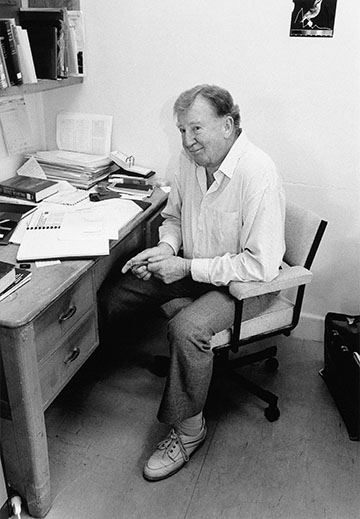 |
The AWRI community was saddened to hear of the death of Dr Chris Somers in April this year. Dr Somers was a highly respected researcher at the AWRI from 1962 to 1990 who leaves behind a significant scientific legacy. His highly influential work on wine colour and tannin is known worldwide and forms the foundation for current research in this area. His name lives on in the suite of spectral analyses used today to measure wine colour and phenolics, known as the ‘Somers’ method’. After his retirement, Dr Somers published a book entitled The Wine Spectrum: an approach towards objective definition of wine quality. |
Polysaccharides turning down the heat on white wine |
|
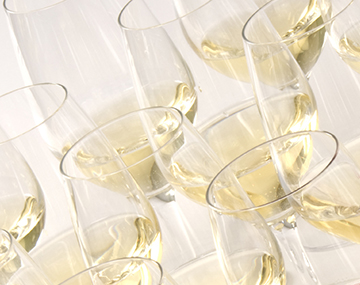 |
Polysaccharides in white wine can inhibit both tartrate and protein precipitation, which means that higher levels of polysaccharides could lower the amount of energy and bentonite needed to achieve cold and heat stability. But how do increased levels of polysaccharides affect white wine mouth-feel? In a recently published study, white wines ‘fortified’ with realistic levels of white wine polysaccharides were seen as less ‘hot’ and in the case of higher pH wines, more viscous.
The study also found that the polysaccharides from grape pulp and those released by yeast during ferment were most likely responsible for the reduced hotness and increased fullness. Alcohol level and pH were found to be the largest influencers of mouth-feel and tastes in white wine – hotness, bitterness, fullness, acidity and astringency – making these key parameters for winemakers. The full paper detailing these results is accessible via the AWRI library: Gawel, R., Smith, P.A., Waters, E.J. 2016 Influence of polysaccharides on the taste and mouthfeel of white wine. Aust. J. Grape Wine Res. DOI: 10.1111/ajgw.12222 |
Grazing sheep in vineyards to cut fuel useFor many growers the biggest source of greenhouse gas (GHG) emissions from the vineyard is from fuel use. Australian vineyards are generally highly mechanised, and diesel is also used on some properties to pressurise irrigation systems. Using sheep to control midrow and undervine growth is one option to reduce the need for slashing and spraying and therefore reduce vineyard management costs and GHG emissions. Cumulus Vineyards in Orange, NSW recently trialled the use of sheep in the vineyard to assess the impacts on vineyard inputs, especially fuel use. The results of the trial led to Cumulus Vineyards grazing sheep across their entire 508 hectares which saved two tractor passes through the vineyard per year (one for slashing and one for spraying herbicide). The full results and more information about sheep grazing in vineyards can be found in a new case study developed as part of the Extension and Outreach project funded by the Australian Government Department of Agriculture and Water Resources. The AWRI Extension and Outreach team will be presenting a suite of new case studies including this one in a series of workshops around Australia in the coming months. Workshops will be publicised through regional associations, email notifications, the AWRI website, the Australian Grape and Wine Events Calendar and Twitter. For more information, please visit the AWRI website here or contact the AWRI helpdesk on helpdesk@awri.com.au or 08 8313 6600. |
|
Lees – minimising product losses and maximising qualityWine lees are typically processed by rotary drum vacuum filtration to recover the wine that is tied up in the lees. This can, however, result in product losses and quality downgrades. The AWRI is currently conducting research on wine lees and is convening an AWITC workshop on lees (W37) on 27 July in Adelaide. In this workshop you will hear from wineries that have trialled or adopted some of the newest alternative technologies for lees recovery. You will also discover the latest results from the AWRI’s research project. For more information, download this article published in the March issue of Aust. N.Z. Grapegrower & Winemaker, or contact Simon Nordestgaard (simon.nordestgaard@awri.com.au or 08 8313 6600). Registrations for the conference and workshop are now open at http://www.awitc.com.au/registration. |
|
Restarting stuck or sluggish fermentsThe AWRI sent out an eBulletin on stuck fermentations last month in response to several wineries encountering stuck or sluggish fermentations. Winemakers were advised to take action quickly to rack wines off ferment lees and to conduct a restart or rescue scale up-based procedure to finish their ferments. The AWRI restart procedure was prepared with assistance from the major yeast suppliers and has a successful track record. Extra information on managing difficult ferments can also be found in the following article:
For further assistance or information on stuck ferments, contact the AWRI helpdesk on helpdesk@awri.com.au or 08 8313 6600. |
|
‘Dog book’ updates in progressThe preparation of the 2016/17 edition of Agrochemicals registered for use in Australian viticulture (the ‘Dog Book’) has begun. Manufacturers of agrochemicals used in viticulture are being contacted to find out about any new or discontinued products. The recommended withholding periods for grapes destined for export wines are also being carefully reviewed, in conjunction with the Agrochemicals Reference Group. Once completed, the information in the updated ‘Dog Book’ will be made available via both print and online formats, with the printed ‘Dog Book’ usually distributed in July. For more information about the ‘Dog Book’, contact Marcel Essling on 08 8313 6600 or marcel.essling@awri.com.au. |
|
AWITC – time to book workshops, dinner tickets and accommodation |
|
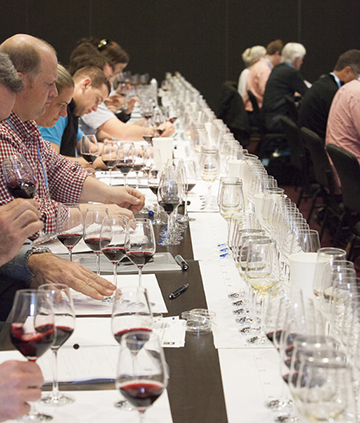 |
You may have already registered for the upcoming Australian Wine Industry Technical Conference (which incorporates WFA’s Outlook Conference) but have you booked everything you need to make the most of your time in Adelaide? Conference workshop places are filling fast and the Maurice O’Shea Award Dinner will be a highlight of the week.
There are 39 workshops to choose from, held over three timeslots on Sunday 24 July and Wednesday 27 July. Topics include social media tips, canopy management, lean production, organic viticulture, hot and cold stability, oak, wine flavour, lab testing, taxation, sparkling wine and clones for climate change. All the details are available on the AWITC workshop page. The Maurice O’Shea Award Dinner will take place on Monday 25 July, a short tram ride away from the conference at the Adelaide Entertainment Centre. This dinner is always a very special night for the Australian wine community and, like the WFA Outlook sessions, is being held in conjunction with the AWITC for the first time in 2016. Conference delegates are eligible for discounted tickets to the dinner – so make sure you book your tickets through the AWITC. If you have already registered for the conference, email info@awitc.com.au to add workshop and dinner tickets to your registration. If you haven’t registered yet, you can book everything in one place on the AWITC registration page. If you have any trouble, just call the AWITC office on 08 8313 6821. Special accommodation rates are also available for AWITC delegates – book via the AWITC accommodation page. |
Order the latest AWRI staff publications onlineAccessing the latest AWRI publications is easy. Visit the AWRI Publications web page to:
A full list of AWRI publications published since the last eNews is included below: 1806 Crauwels, S., Van Assche, A., de Jonge, R., Borneman, A.R., Verreth, C., Troels, P., De Samblanx, G., Marchal, K., Van de Peer, Y., Willems, K.A., Verstreppen, K.J., Curtin, C.D., Lievens, B. Comparative phenomics and targeted use of genomics reveals variation in carbon and nitrogen assimilation among different Brettanomyces bruxellensis strains. Appl. Microbiol. Biotechnol. 99: 9123-9134; 2015. 1807 Williamson, P.O., Lockshin, L., Francis, I.L., Loose, S.M. Influencing consumer choice: short and medium term effect of country of origin information on wine choice. Food Qual. Pref. 51: 89-99; 2016. 1808 Nordestgaard, S., Abbott, T. Winery lees: minimising volumes and recovering better quality juice and wine. Aust. N.Z. Grapegrower Winemaker (626): 62-64; 2016. 1809 Cowey, G. Ask the AWRI: Predicting alcohol levels. Aust. N.Z. Grapegrower Winemaker (626): p. 68; 2016. 1810 Johnson, D. Teasing [OUT] terroir. WBM (March/April): 56-57; 2016. 1811 Ristic, R., Fudge, A.L., Pinchbeck, K.A., de Bei, R., Fuentes, S., Hayasaka, Y., Tyerman, S.D., Wilkinson, K.L. Impact of grapevine exposure to smoke on vine physiology and the composition and sensory properties of wine. Theor. Exp. Plant Physiol. 28 (1) 67-83; 2016. 1812 Stockley, C.S. The relationships between alcohol, wine and cardiovascular diseases – A review. Nutr. Aging 3 (2-4): 55-88; 2015. 1813 Bekker, M.Z., Mierczynska-Vasilev, A., Smith, P.A., Wilkes, E.N. The effects of pH and copper on the formation of volatile sulfur compounds in Chardonnay and Shiraz wines post-bottling. Food Chem. 207: 148-156: 2016. 1814 Mierczynski, P., Vasilev, K., Mierczynska, A., Maniukiewicz, W., Szynkowska, M.I., Maniecki, T.P. Bimetallic Au-Cu, Au-Ni catalysts supported on MWCNTs for oxy-steam reforming of methanol. Appl. Catal. B Environ. 185: 281-294; 2016. 1815 Lee, D., Lloyd, N.D.R., Pretorius, I.S., Borneman, A.R. Heterologous production of raspberry ketone in the wine yeast Saccharomyces cerevisiae via pathway engineering and synthetic enzyme fusion. Microb. Cell Fact. 15 (49): 1-7; 2016. 1816 Taylor, A., Barlow, N., Day, M.P., Hill, S., Patriarca, M., White, M. Atomic spectrometry update: review of advances in the analysis of clinical and biological material, foods and beverages. J. Anal. At. Spectrom. 31 (3): 554-595; 2016. 1817 Curtin, C., Cordente, T. What’s old is new again: yeast mutant screens in the era of pooled segregant analysis by genome sequencing. Microbial Cell 3 (4): 1-2; 2016. 1818 Varela, C., Sengler, F., Solomon, M., Curtin, C. Volatile flavour profile of reduced alcohol wines fermented with the non-conventional yeast species Metschnikowia pulcherrima and Saccharomyces uvarum. Food Chem. 209: 57-64; 2016. 1819 Moran, M., Petrie, P., Sadras, V. Sensory attributes of Barossa Shiraz 2015 in response to warming and pruning date. Aust. N.Z. Grapegrower Winemaker (627): 50-51; 2016. 1820 Stockley, C. Ask the AWRI: Health and nutrition labelling. Aust. N.Z. Grapegrower Winemaker (627): p. 66; 2016. 1821 Waterhouse, A.L., Lamuela-Raventós, R.M., Quifer-Rada, P., Stockley, C.S. Wine. Shahidi, F., Alasalvar, C. (eds.) Handbook of functional beverages and human health. Boca Raton, FL: CRC Press Taylor & Francis Group LLC: 739-755; 2016. |
|
AcknowledgementThe AWRI acknowledges support from Australia’s grapegrowers and winemakers through their investment body, Wine Australia, with matching funds from the Australian Government. The AWRI is a member of the Wine Innovation Cluster in Adelaide, South Australia. |
|
Stuck ferments need a rapid response
19 April 2016 >19 April 2016
As vintage draws to a close, the AWRI helpdesk is seeing an increase in enquiries related to stuck fermentations. The main drivers for stuck ferments this year have been high sugar levels, and thus higher alcohol concentrations, causing ferments to become sluggish. The majority of the stuck ferments so far have not been related to issues such as unusual organic acid profiles, high SO2 levels, low YAN levels or agrochemical residues.
If a stuck ferment is identified, winemakers are advised to take action quickly and not just hope the issue will go away. Problematic ferments should be addressed as soon as possible. If in doubt, follow the AWRI’s procedure for rescuing a stuck ferment. Note that it is important to keep tanks at around 20-22°C and off ullage.
Further fermentation resources, including tools for graphing ferments and the wine fermentation simulator tool, can be found on the AWRI’s wine fermentation web page.
For assistance with tracking or restarting your ferments, please call the AWRI helpdesk team on 08 8313 6600 or email helpdesk@awri.com.au.
Technical Review April 2016 issue available online
13 April 2016 >The April 2016 issue of Technical Review is now available online. Articles and abstracts can be viewed individually, or the full issue can be downloaded. The online format of Technical Review allows you to browse the list of the latest articles on grape and wine production by keyword, view article summaries and order journal articles from the AWRI Library.
For copyright reasons, access to abstracts is available only to Australian winemakers and grapegrowers who pay the Wine Grapes or Grape Research levies. The technical notes authored by the AWRI are, however, freely available. If you have forgotten your password for the AWRI website, please use the forgotten password link to reset your password.
Below is a snapshot of what’s in this issue:
| AWRI Technical Notes | |
| AWRI publications |
|
| Current literature – oenology |
|
| Current literature – viticulture |
|
eNews – March 2016
15 March 2016 >The power of oxygen during fermentation
Is your winery water creating musty wines?
Vineyards and wineries contributing to decreasing greenhouse gas emissions
International alcohol policy changes
Events coming up after vintage
Revised version of the Food Standards Code
Order the latest AWRI staff publications online
Investigation of grape and wine production practices |
|
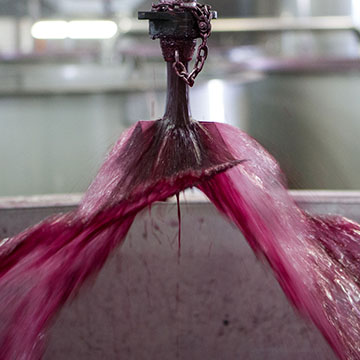 |
Recently published AWRI research has shown that the formation of reductive aroma compounds (such as hydrogen sulfide, methanethiol, ethanethiol and their corresponding thioacetates) is significantly affected by treating wines with O2 in the early stages of fermentation. In fact, the formation of some of these compounds in a Shiraz wine was completely eliminated through careful O2 dosage early in fermentation. These wines showed desirable red and dark fruit aromas when assessed by a sensory panel.
Commonly used remediation treatments were also assessed for their effectiveness in removing ‘reductive aromas’ from wines that had been treated reductively. Early copper fining was the most effective treatment; however, none of the treatments were able to produce wines with sensory profiles similar to wines treated oxidatively during fermentation. The full paper detailing these results is accessible via the AWRI library: Bekker, M.Z., Day, M.P., Holt, H., Wilkes, E., Smith, P.A. 2016. Effect of oxygen exposure during fermentation on volatile sulfur compounds in Shiraz wine and a comparison of strategies for remediation of reductive character. Aust. J. Grape Wine Research 22(1): 24–35. |
Is your winery water creating musty wines? |
|
| In the past six months the AWRI helpdesk has investigated a number of cases of ‘musty’/‘TCA-like’ characters in wine. Interestingly, a large percentage of these investigations have identified water as the source of contamination. Tests of winery water supplies have confirmed the presence of TCA (2,4,6-trichloroanisole), which is an extremely potent ‘musty’ aroma compound, perceptible in wine at parts per trillion levels. However, it hasn’t been possible to identify the source of the TCA in the water. In one investigation, a number of wines became contaminated after musty water was used to rinse a cross flow filter.
This is not the first time the helpdesk has seen contamination of wines from musty water. To decrease the risk of this type of contamination, the helpdesk team advises that water used in the winery should be assessed routinely to ensure musty characters are not present. People vary in their sensitivity to musty taints, so it may be important to use more than one person to assess water samples regularly and to conduct the assessments in an environment that doesn’t have background musty aromas. For assistance in dealing with contamination problems, please contact the AWRI helpdesk on 08 8313 6600 or helpdesk@awri.com.au. TCA analysis of wine and water samples is available from AWRI Commercial Services. |
|
App updates |
|
| The AWRI supports two free apps for Australian grapegrowers and winemakers – The AWRI Agrochemical Search app and the AWRI Winemaking Calculators app.
The Agrochemicals app allows growers to quickly identify agrochemicals for use in the production of grapes for export wine and comply with any restrictions on their use. The Winemaking Calculators app provides a single access point for a wide range of important wine-related calculations – including fining rates, acid or SO2 additions, conversions and standard drinks calculations. Both apps are available for Apple and Android platforms, with a recent update ensuring compatibility with Android 5.0. If Android users have experienced any issues with either app in the past, it is recommended to delete the apps and re-install them from Google Play to ensure access to the latest version. For assistance with either app, please contact the AWRI helpdesk. |
|
Vineyards and wineries contributing to decreasing greenhouse gas emissionsLate last year, an ambitious deal was struck by international leaders at the Paris Climate Conference, with an agreement signed by 197 countries. This agreement stated that greenhouse gas (GHG) emissions should peak “as soon as possible,” followed by rapid reductions and a five-year cycle for reviewing emissions cuts with action to be continually ratcheted up. Australia’s commitment is to reduce GHG emissions by 26 to 28 per cent below 2005 levels by 2030 primarily through the Emissions Reduction Fund, a government-financed fund which purchases emission reductions credits, and the Renewable Energy Target of 23% renewables by 2020. The AWRI provides an online tool to assist grape and wine businesses to measure and benchmark GHG emissions. In 2014/15 for the first time, vineyards and wineries reported their use of on farm and business generated renewable electricity through Entwine Australia. The results showed 11% of Entwine members were generating renewable energy. Small wineries (500-2000 tonnes) had the highest uptake of renewable energy generation, reporting an average of 30% of their electricity needs being supplied by renewables. Vineyards reported significantly higher proportions of their electricity needs being supplied by renewables. Of the 43 vineyards using renewable energy, 15% generated more than 100% of their requirements with some reporting electricity generation 3 to 35 times the amount required in the vineyard. Those vineyards generating less than 100% of their electricity averaged around one-third of their total electricity requirements. Australian wine-grape growers and winemakers can access the new Australian Wine Carbon Calculator and benchmarking tool by becoming members of Entwine Australia. For more information, please visit the Entwine Australia page on the AWRI website or contact the AWRI helpdesk helpdesk@awri.com.au or by telephone 08 8313 6600. |
|
International alcohol policy changesTwo countries (the UK and Malaysia) are currently proposing changes to aspects of their public health policy on alcohol. These changes are consistent with the World Health Organization’s recently recommended strategies to reduce alcohol-related harms, especially in vulnerable or ‘at high risk’ population groups such as youth and young adults. The changes are relevant to Australia because they could be taken into consideration when the Australian drinking guidelines are reviewed later this year. On 1 December 2015, Malaysia notified the World Trade Organisation (WTO) that it plans to raise the minimum age for legal alcohol consumption from 18 to 21 years. This forms part of a strategy that aims to limit the accessibility of alcohol to high risk groups. The majority of countries have a minimum age of 18 years for legal alcohol consumption. The UK government has opened a public consultation on proposals to change its alcohol drinking guidelines. The main proposed changes are that both men and women should not consume more than 14 UK (8 g) units of alcohol per week. Compared to the current guidelines, this is a reduction in amount and a change from a daily to a weekly limit. The current guidelines suggest that men should not regularly consume more than 3-4 UK units per day and women 2-3 UK units per day. More information about the proposed change is available from this website. |
|
What’s new in eBooks? |
|
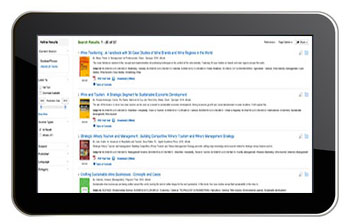 |
Seven new eBooks have recently been added to the AWRI’s collection, with topics covering the US and Chinese wine industries, vineyard soils, winery tourism and climate change.
To keep in touch with the eBooks collection and access the latest books, visit the new eBook titles page on the AWRI website. Not sure how to go about reading an eBook? Check out this this webinar or contact the AWRI information services team (infoservices@awri.com.au ). |
16th AWITC deadlines in April |
|
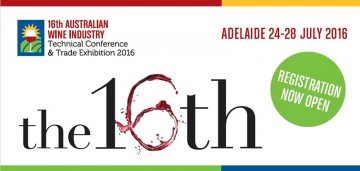 |
While July might still seem a long way away, there are some key AWITC deadlines coming up soon. Both early bird registrations and poster abstract submissions close on 15 April 2016. A detailed program is now available, with just a few final speakers to confirm. Register now to lock in early bird prices and secure your preferred workshop places. Discounted tickets to the Maurice O’Shea Award Dinner are available to AWITC delegates and can be purchased as part of your registration.
The poster display is an essential element of every AWITC and a great opportunity to present the latest research outcomes to a large industry audience. Poster authors are eligible to win a prize or to be selected to present in one of the ‘Fresh Science’ sessions. Submit your abstract online before 15 April or contact Dr Eveline Bartowsky, Poster Coordinator, at posters@awitc.com.au if you have any questions. For any other conference-related queries, please contact Kate Beames, Conference Manager on 08 8313 6821 or kate.beames@awitc.com.au. |
Events coming up after vintageThe AWRI’s extension activities (seminars, workshops and webinars) take a break during vintage, but will be ramping back up from mid-April. In the webinar program, topics coming up include cover crops, managing oxygen during winemaking, redirecting rain to manage salinity and the effects of closures on shelf life. Three trunk disease management workshops will be presented in Victoria in late April, and three sustainability workshops will be held in May in Mt Barker (WA), McLaren Vale and Orange. The next roadshow seminar will be in Coonawarra on 31 May and two ‘Adapting to Difficult Vintages’ workshops will be presented in Rutherglen and Goulburn Valley in late June. For details on all of these events, visit the AWRI events calendar, contact your local association or email the events team at the AWRI. |
|
Revised version of the Food Standards CodeA revised version of the Australia New Zealand Food Standards Code came into effect on 1 March 2016. This Code houses winemaking regulations related to additive and processing aid permissions as well as maximum agrochemical limits, other residue information and some labelling specifications. The Code had been revised so it more closely aligns with Food Acts in Australian states and territories and in New Zealand, but while it looks very different, the changes are relatively minor in nature. A summary of the changes and the new version of the Code are available online. |
|
Order the latest AWRI staff publications onlineAccessing the latest AWRI publications is easy. Visit the AWRI Publications web page to:
A full list of AWRI publications published since the last eNews is included below. 1790 Geffroy, O., Yobrégat, O., Dufourcq, T., Siebert, T., Serrano, E. Certified clone and powdery mildew impact Rotundone in red wine from Vitis vinifera L. cv. Duras N. J. Int. Sci. Vigne Vin 49 (4): 231-240; 2015. 1791 Longbottom, M. ASVO announces new board line-up and Fellow, bolsters industry collaboration. Wine Vitic. J. 31 (1): 10; 2016. 1792 Abbott, T., Longbottom, M., Wilkes, E., Johnson, D. Assessing the environmental credentials of Australian wine. Wine Vitic. J. 31 (1): 35-37; 2016. 1793 Dry, P. Graciano. Wine Vitic. J. 31 (1): p. 57; 2016. 1794 Gawel, R., Schulkin, A., Day, M., Barker, A., Smith, P.A. Interactions between phenolics, alcohol and acidity in determining the mouthfeel and bitterness of white wine. Wine Vitic. J. 31 (1): 30-34; 2016. 1795 Kilmister, R., Unwin, D., Treeby, M., Edwards, E., Krstic, M. Effect of elevated CO2 and temperature on phenology, carbohydrates, yield and grape composition – preliminary results. Wine Vitic. J. 31 (1): 38-40, 42; 2016. 1796 Borneman, A.R., Forgan, A.H., Kolouchova, R., Fraser, J.A., Schmidt, S.A. Whole genome comparison reveals high levels of inbreeding and strain redundancy across the spectrum of commercial wine strains of Saccharomyces cerevisiae. G3 DOI:10.1534/g3.115.025692; 2016. 1797 Lockshin, L., Corsi, A.M., Cohen, J., Lee, R., Williamson, P. West versus East: measuring the development of Chinese wine preferences. Food Qual. Pref. DOI: 10.1016/j.foodqual.2016.02.014; 2016. 1798 Wang, J., Capone, D.L., Wilkinson, K., Jeffery, D.W. Rosé wine volatile composition and the preferences of Chinese wine professionals. Food Chem. 202: 507-517; 2016. 1799 McRae, J.M., Bindon, K.A., Hixson, J.L., Smith, P.A. Wine tannin structure and extraction: Review of current research. Combs, C.A. (ed.) Tannins: Biochemistry, food sources and nutritional properties. New York, USA: Nova Science Publishers: 85-120; 2016. 1800 Stockley, C.S. A review of the relationship between wine consumption and type 2 diabetes mellitus. J. Nutr. Therapeut. 4(4): 124-134; 2015. 1801 Cavallaro, A., Mierczynska, A., Barton, M., Majewski, P., Vasilev, K. Influence of immobilized quaternary ammonium group surface density on antimicrobial efficacy and cytotoxicity. Biofouling 32(1): 13-24; 2016. 1802 Petrie, P. Ask the AWRI: Measuring canopy size. Aust. N.Z. Grapegrower Winemaker (625): 36-37; 2016. 1803 Zhang, P., Fuentes, S., Siebert, T., Krstic, M., Herderich, M., Barlow, E.W.R., Howell, K. Terpene evolution during the development of Vitis vinifera L. cv. Shiraz grapes. Food Chem. DOI: 10.1016/j.foodchem.2016.02.125; 2016. 1804 Stockley, C.S. Wine consumption, cognitive function and dementias – A relationship? Nutr. Aging 3 (2-4): 125-127; 2015. 1805 Stockley, C.S. Role of wine components in inflammation and chronic diseases. Moreno-Arribas, M.V., Sualdea, B.B. (eds.) Wine safety, consumer preference and human health. Cham, Switzerland: Springer: 241-258; 2016. |
|
AcknowledgementThe AWRI acknowledges support from Australia’s grapegrowers and winemakers through their investment body, Wine Australia, with matching funds from the Australian Government. The AWRI is a member of the Wine Innovation Cluster in Adelaide, South Australia. ‘The power of oxygen during fermentation’ image is courtesy of Eric Wilkes. |
|
AWRI Report – Jan/Feb 2016
10 March 2016 >New AWRI Report from the latest Wine & Viticulture Journal on Assessing the environmental credentials of Australian wine. Click below to read it now.
Agrochemical update March 2015
3 March 2016 >Fenarimol (Rubigan SC) stocks to be used up
The registration for the powdery mildew active constituent Fenarimol (DuPont product Rubigan SC) has not been renewed. As such, growers have until 30 June 2016 to use up any stock they have of this agrochemical. After this date, leftover stock will need to be disposed of.
Some growers may wish to use up their stock of Rubigan SC by conducting a post-harvest application to control powdery mildew. When considering this option, growers should be aware of the CropLife Australia resistance management restrictions on the Group 3 fungicides. These state:
- DO NOT apply more than two consecutive sprays of a Group 3 fungicide.
- DO NOT apply more than three Group 3 sprays per season.
- DO NOT use Group 3 fungicides curatively.
If disposal of unused stock is required, growers can register with ChemClear at http://chemclear.com.au/ or by calling toll free on 1800 008 182. Local Environment Protection Agencies may also be able to advise on other disposal mechanisms.
A list of alternative chemicals for the control of powdery mildew can be found on page 8 in the ‘Dog Book’ – accessible in several different formats on the AWRI website.
For more information, please contact Marcel Essling on 08 8313 6600 or email helpdesk@awri.com.au.

